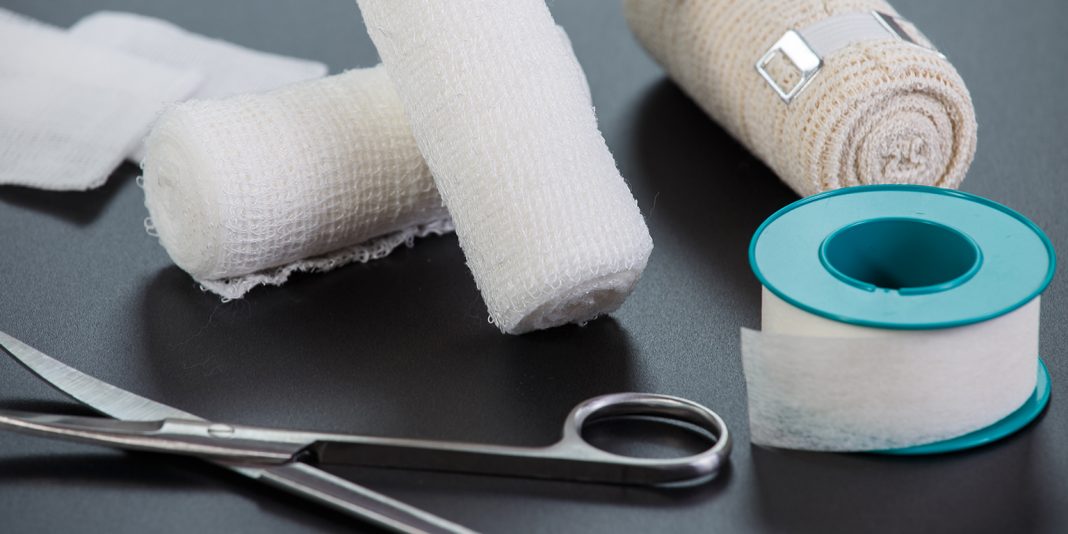The aim of wound care is always to help, not hinder, the healing of a wound.
There is a myriad of modern dressings available to aid wound healing but wound care nurse specialist Emil Schmidt says to make the most of these – often quite expensive – products you first need to ensure the wound bed is properly prepared.
For this the wound needs to be not only cleaned but also often debrided. Schmidt has been working as the Southern District Health Board’s wound care specialist for more than a decade and in 2013 also became the president of the New Zealand Wound Care Society. Earlier this year he presented on aspects of debridement at the society’s biennial conference in Blenheim.
Schmidt says sometimes people get confused over the differences between cleansing a wound and debriding a wound. To put it simply, cleansing usually involves washing a wound to remove loose dirt and foreign materials, while debridement is the removal of dead, adhered and contaminated tissue and needs to continue until a healthier wound bed has been created. “So debridement can also be referred to as a form of wound bed preparation.”
Wound bed preparation is particularly important in chronic wounds like leg ulcers, where health professionals often need to intervene to facilitate or speed up the healing process.
This article looks at how nurses can use debridement so modern wound dressings can be placed on a healthy wound bed and be their most effective.
“If we don’t prepare the wound properly, modern wound dressings are a waste of time and money,” says Schmidt.
Deciding which form to use
Debridement itself can take many forms. Deciding when to debride a wound, and the most appropriate form, depends on many factors.
There first needs to be a full assessment of the patient, including their level of pain, circulation and any comorbidities (such as diabetes).The diagnosis of different tissue types and bioburden (viable bacteria) covering the wound, combined with the state of the wound edge as well as the periwound skin, will assist in deciding which form of debridement will be the most appropriate.
Schmidt says the rough rule of thumb is that all wounds with dead tissue (i.e.slough) need to be considered for debridement. What needs to be taken into account is the speed of healing.
“If the wound, despite a moderate amount of slough, is healing then obviously there is no problem,” he says. “But if the wound is covered with tenacious slough, the wound edges are not progressing, the surrounding skin is macerated and the wound is static, then you need to act, because the slough is delaying wound healing, and is often harbouring harmful bacteria that is critically colonising the wound.”
If wound healing has come to a halt then some form of debridement is indicated. The right diagnosis and identifying the tissue type is important to define the right time for debridement and to identify the most appropriate method. Another important factor is to define the exudate levels of the wound bed (ranging from dry to wet). Other parameters that need to be considered include pain, the patient’s environment, quality of life, patient’s choice, age and, in particular, the skill and resources of the health professional.
If the assessment reveals that the wound may already be outside of the particular nurse’s skill set – for example, it is showing signs of local infection, is painful, odorous, has a lot of dead tissue or lot of tenacious slough– then it is important to seek support from a wound care specialist. The earlier the better, says Schmidt, who often gets photos of wounds emailed to him by colleagues from throughout Otago seeking advice on wounds they are treating. He says often a sound care plan can be established using email consultation, and he values and is very proud of the close working relationships he has developed over the years with many healthcare professionals in Otago.
Wound care plan important
Before starting any form of debridement, Schmidt emphasises the importance of debridement being seen as part of an integrated wound care plan. For example, he says it doesn’t make sense to just look at the sticky slough on a lower leg and apply a hydrogel to an ulcer without using appropriate compression support.
The wound care plan needs to include the aims of the debridement, timeframe and a goal.
Those goals (i.e. reducing the amount of dead tissue) need to be reassessed at regular intervals. If the goals haven’t been achieved then an alternative plan should be considered. Again he says, bear in mind that assistance is only a phone call or an email away.
The type of debridement will not only be influenced by the wound and patient assessment but also by the clinical setting, as the range of debridement products and tools available to a nurse in a general practice or a rest home may differ greatly from those available to a wound specialist in a tertiary hospital or outpatient clinic. The skills and experience of the nurse also need to be considered, along with any workplace regulations or guidelines they work under.
Schmidt says forms of debridement can be loosely grouped into several categories.
Autolytic debridement
Autolytic debridement is the most common form used and basically involves encouraging or enhancing the body’s natural debridement process by keeping the wound moist.
A wound can naturally rid itself of dead cells by producing slough, which is often quite wet, says Schmidt. The moist slough helps shift and shed the dead or non-viable tissue from the wound bed but when the slough dries and becomes sticky the natural debridement process can need a helping hand.
Autolytic debridement involves adding a dressing with a high water content to the wound to moisten and loosen the thickened slough or necrotic tissue.
Dressings commonly used for this purpose include hydrogel orhydrocolloid and all operate on the principle that they add moisture to the wound bed.
These dressings are usually changed three or four times a week until the slough can be removed by simply washing the wound. Autolytic is the least invasive of the debridement techniques, says Schmidt. It doesn’t require specialist skill and should be able to be applied in many healthcare settings. Some of the advantages are that it is virtually pain free. However, autolytic debridement also has its disadvantages. It is a slow process, can lead to maceration of the surrounding skin and the moist environment can potentially allow bacteria to multiply.
Enzymatic debridement
Patients with chronic wounds have been treated with topical application of proteolytic enzymes, found naturally in fruits like papaya and kiwifruit, for hundreds of years. Enzymatic debridement uses proteolytic enzymes (proteinases) to help break down proteins in the wound or slough. Few commercially available enzyme products are available here in New Zealand.
Mechanical debridement
Traditionally mechanical debridement involves applying a dry gauze dressing to a wound. After the wound dries out – and the dead tissue sticks to the gauze – the dressing is ripped off, removing the dead tissue and dry slough with it.
“That can be very, very painful and is not recommended practice,” says Schmidt.
Recently another form of mechanical debridement became available in New Zealand using a monofilament pad (Debrisoft) that is said to be a less painful method.
Larval (or biosurgery) debridement
Larval debridement (maggot therapy) is now more readily available in New Zealand. The local supplier of sterile medical maggots last year reported up to several orders a week from nurses and doctors using larval debridement on hard-to-heal wounds.
Schmidt says the method is most often used by wound care specialists and specially trained district nurses. “It has to be the right diagnosis, tissue type and patient who can tolerate this type of treatment. “The larvae feed on dead tissue and exudates within the wound and therefore remove devitalised tissue. The digestive juices secreted by larvae contain proteolytic enzymes which selectively debride dead tissue, leaving viable tissue unharmed.
“Maggots are like micro-surgeons as they won’t touch living tissue,” says Schmidt. Special protocols need to be followed to ensure it is the right method for the wound and the larvae can do their job effectively.
Direct debridement
In recent years a number of new high-tech forms of debridement have been introduced – mostly for use in hospitals but also some specialist clinics.
These include Versajet, in which a high-flow jet of sterile water is directed at the wound to wash away dead tissue (also known as hydrosurgery) while the patient is under anaesthetic. Another form is low frequency ultrasound debridement (LFUD) that uses ultrasonic waves combined with highly charged saline bubbles to debride wounds. LFUD can be safely used on the bedside or in an outpatient setting, saving theatre time and aiding early discharge. This technique has been used overseas for a decade but hardly ever in
New Zealand. Schmidt has been using the only system available in the country for almost three years. He and his vascular team colleagues are currently undertaking a three-year-long, randomised control trial in Dunedin Hospital on all patients with lower limb wounds and he says that early results are very promising.
Conservative sharp debridement
Conservative sharp debridement requires training, experience and confidence to perform safely. This form of debridement involves using a sterile sharp spoon (curette), scissors or scalpel to remove necrotic tissue. A thin margin of non-viable tissue is left surrounding the wound bed. “So it doesn’t go into bleeding tissue”, says Schmidt.
Sharp debridement is often done in an outpatient clinic setting. Local anaesthetic may be required for painful wounds.
Surgical debridement
Surgical debridement is more extensive and deeper than sharp debridement and includes cutting into bleeding, living tissue. It is often, but not exclusively, done in an operating theatre.
Lack of guidelines in Australasia for sharp and surgical debridement
Schmidt, in his role as president of the New Zealand Wound Care Society, is very conscious of the lack of a recognised training framework or guidelines for sharp and surgical debridement in Australasia.
Nurses are expected to use their professional judgement of what is within their skills and scope, so only experienced wound care nurses will carry out sharp or surgical debridement.
But at present there is no formal certification programme to assure the patient, (or the nurse) that they have the necessary skills, unlike the United States where individual state boards of nursing set out clear guidelines on what skills are required to be competent to perform sharp debridement.
“It is a complex topic, not only inNew Zealand but throughout the Australasia region, as lots of colleagues debride [sharp or surgical] but there is no standardised training programme,” says Schmidt. Often nurses specialising in wound care first learn by watching others and then hone their skills under the supervision of a surgeon, podiatrist or other specialists, so in time it can become part of their own practice skill set.
The New Zealand Wound Care society always includes a sharp debridement training workshop at its conference where nurses can learn some theory and do some practical debridement sessions. Those workshops are extremely popular and are booked out very quickly. But there is no national, standardised training framework where a recognised qualification can be obtained, which is a concern as sharp debridement can be potentially dangerous.
“Nursing colleagues tell us that they want more formal training,” Schmidt says.
He says the New Zealand and Australian wound care societies have worked successfully together to write guidelines for leg ulcer and the prevention of pressure injuries and he is hopeful that in the future the societies will also develop standards and an educational framework for debridement.
Meanwhile, unless nurses are trained to the point that they are competent, they should not attempt sharp debridement and opt instead for a less invasive debridement form. It’s most important to remember that if a wound is not healing within a certain timeframe then help should be sought from a wound care specialist. :
Reference
Strohal R, Apelqvist J, Dissemond J et al. EWMA Document: Debridement. Journal of Wound Care 2013; 22 (Suppl. 1): S1–S52.
Debridement versus cleansing
Cleansing: In simplest definition it is the removal of loose dirt or foreign materials from a wound. Usually involves washing wound with warm saline (or water) and can include using a syringe or mechanical irrigation of a wound.
Debridement: The preparation of a healthy wound bed for healing by the removal of dead, contaminated or sloughy tissue
Types of debridement include
- Autolytic
- Enzymatic
- Mechanical
- Larval
- Conservative sharp
- Surgical
- HighTech (direct)
Sharp debridement use survey
A few years ago one of Australasia’s top wound care consultants, Jan Rice, carried out a survey to find out how many wound care nurses were using sharp debridement and how they were trained.
She received responses from 12 nurse practitioners and 14 clinical nurse specialists working in community nursing services. The vast majority reported using conservative sharp wound debridement with the NPs using scalpels, scissors and curettes and the community nurses using scalpel and scissors only. The NPs were most likely to report using sharp debridement on more than half of the wounds they treated each week with the community nurses requiring the skill less often.
The surveyed NPs reported being trained by a surgeon mentor in sharp debridement and the community nurses had learnt from seminars, conferences and peer respected clinicians. All saw a need for a nationally recognised training programme in conservative sharp debridement with 75 per cent of the community nurses seeing the need as urgent.























